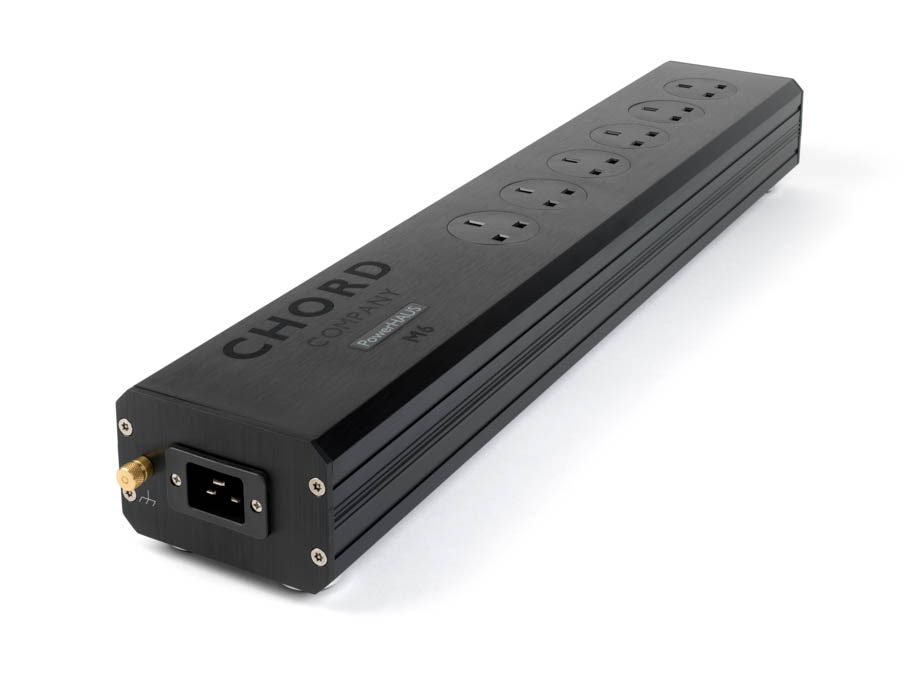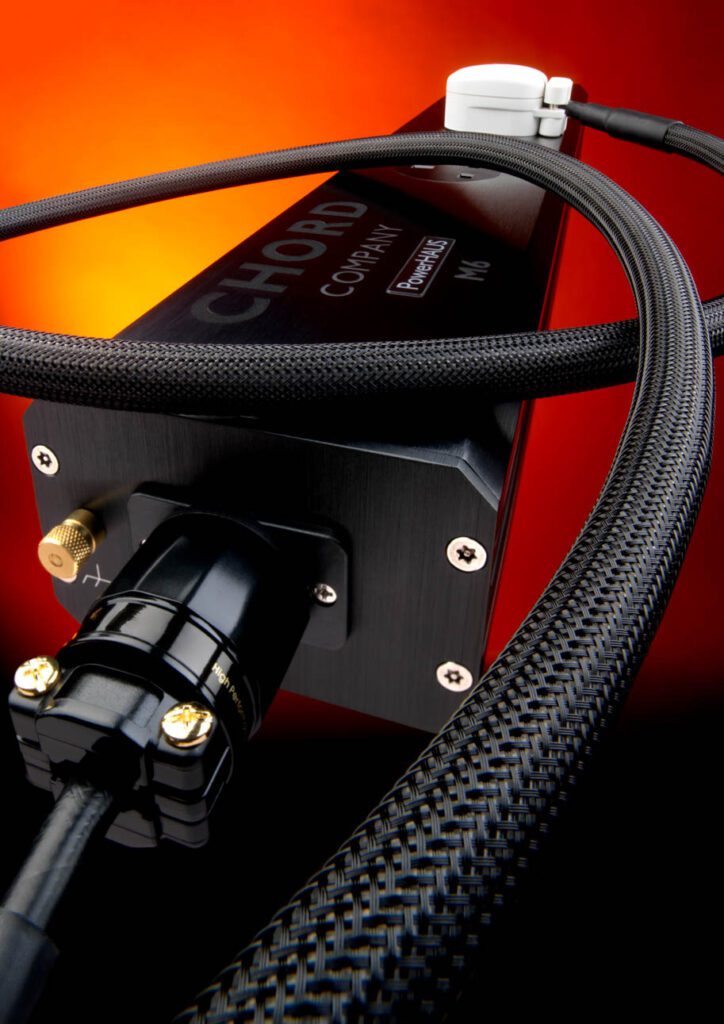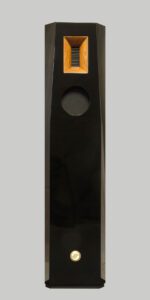
First, we had loudspeaker cables. Then, interconnect cables. Then, somebody noticed that paying attention to the way your equipment connects to the mains power can also make a difference to sound quality. Chord Company has made speaker, interconnect and mains cables for rather longer than most, but despite their long-standing reputation for quality cables, they have never offered a mains block. Until now. Apparently, Chord Company started development of mains distribution products as far back as 2003, so has it been worth the wait?
Filter or ground?
There are several schools of thought around mains distribution and the best way to address the objectives. One is about earthing, getting a reliable and stable ground for your equipment; another is around noise suppression, either by filtering, or regeneration of the mains waveform. Each has its advocates, and its detractors. Personally, I’m not a fan of heavily-filtered mains, I tend to align with those who find it sits on dynamics and saps energy. So I was interested to note that Chord Company doesn’t use heavy filtering, the design draws on the expertise gained from development of their proprietary ARAY technology, first seen on their Sarum Tuned ARAY mains cable, to tackle the various ways noise can enter the system. They’re also ploughing an unconventional furrow on the connections and the earthing topology too, eschewing the oft preferred star-wiring techniques in favour of three isolated bus-bars, physically separating the earth bus from the live and neutral within the unit. The rationale here is that experience suggests the proliferation of switched mode power supplies and other sources of RFI renders star-wiring ineffective in reducing the interaction of live and neutral feeds with the earth, but attention to detail in minimising interplay between live/neutral, and earth, pays dividends.
So PowerHAUS uses both approaches – tackling noise and RFI, and also providing a high quality earth connection. There are two models in the range, PowerHAUS M6 reviewed here, which features three hybrid MainsARAYs in parallel, and the PowerHAUS S6, which retains many of the core design features, but without the advanced ARAY elements of the M6. The M6 is housed in longer casework, the extra space required to house the MainsARAY elements, the S6 takes up little more space than the line of six mains sockets require. Both are in a nicely-finished extruded aluminium casing and receive input feed via a 16 Amp IEC socket, so you’ll need a non standard mains lead for that. I received an Epic power cable to do service here, and I used my usual Nordost Tyr2 mains leads from block to system components.

It doesn’t take long to appreciate the effectiveness of this approach. Tom Waits’ ‘Take it with me’ from Mule Variations [ANTI], vocals are more ‘present’ with clearer enunciation; ‘Georgia Lee’ from the same album has more pathos, due in part to the way the vocals reach out and connect more readily, but there’s also more tunefulness and beauty in the piano, so the contrast is all the more poignant. Overall, there’s more layering, detail and internal structure apparent even in familiar recordings like, um, ‘Familiar’ or ‘Red virgin soil’ from Agnes Obel’s Citizens of Glass [PIAS] – vocals have more substance and texture, rhythms have more pulse and tracks are more propulsive.
Tactility and physicality
Musical notes have their own shape, and hi-fi systems vary in how successfully they preserve the relationship between attack, decay, sustain and reverb parts of the sound envelope. What the PowerHAUS M6 seems to be able to do is provide more space for the system to achieve this. There’s more articulation to notes, diction is clearer, phrasing more apparent, and dynamics more impactful because the individual notes are not bleeding into one another to quite the same extent. The music becomes at once more intelligible, and more communicative. Take The Stanley Clarke Band [Heads Up] and ‘Bass Folk Song No.6’, the upright bass’ textures are more developed, the playing has a tactility and physicality, and it’s clear that the synth backing is more than just background support, and plays an important part in shaping the piece. The music is more complex, more interesting and the musicianship more apparent. We’re much closer to being witnesses to a musical event.
Noise vs energy
Noise is clearly an important factor at play here – whether it’s noise getting in from external sources via the live and neutral, or noise being shared around via the earth, but all the benefits of the PowerHaus M6 are ones I recognise from other work to reduce the insidious, parasitic effect of low-level noise within a system. This two-pronged approach seems to be effective, and any downsides are modest. Set against my regular Nordost mains block, which is priced halfway between the two PowerHAUS models, dynamics and rhythmic integrity are very largely preserved. If I am to pick nits, there is perhaps a small deficit in terms of sheer energy in the output with the M6 block, but this is to a great extent offset by that heightened sense of definition. Dynamics are portrayed with speed and precision: Joanna MacGregor’s solo piano rendition of ‘Libertango’ on Live in Buenos Aires [Sound Circus] is tactile and muscular, aided by this strong sense of separation of the individual notes, the reduced tendency to blend the various elements of the music together. The rhythmic intensity of the piece is all the better for it. And this in turn adds scope to turn the volume up without things falling apart, so you effectively have more control over the energy output.
Would you, should you pay twice the price for the M6 over the S6? I’d say so. Chord Company helpfully sent me a PowerHAUS S6 so I was able to do a brief comparison. Both are strong performers, and if your budget is tight the S6 gets a lot of things right and is well worth your consideration, but assuming your source, amplification and loudspeakers are already competent, the ARAY filtering technology pays significant dividends. I really can’t think of a better way to get the extra musical benefits I’m describing here, for that extra £1,000.
Technical specifications
- Chord Company PowerHAUS M6, 6-way mains distribution block
- Output Six output sockets (UK or Euro)
- Input Input socket 16 amp IEC
- Power rating Outlet ratings 13 amp (UK)/16 amp (EU); Rated power and/or current max 16 A
- Supply voltage 100–250 V
- Frequency 50/60 Hz
- Price £2,000
Manufacturer
Chord Company
Tel: +44(0)1980 625700
Tags: CHORD COMPANY POWERHAUS DISTRIBUTION BLOCK POWERHAUS M6
By Steve Dickinson
More articles from this authorRead Next From Review
See all
PrimaLuna EVO 100 phono preamplifier
- Apr 22, 2024

Reiki Audio SuperSwitch Master Pro + Servant Pro
- Mar 27, 2024

Melco Audio N1-S38 music server
- Mar 27, 2024











